
Refer to PSP 24th Perihelion Campaign page.
2025-06-17 (CSV, PDF table of coordinates)
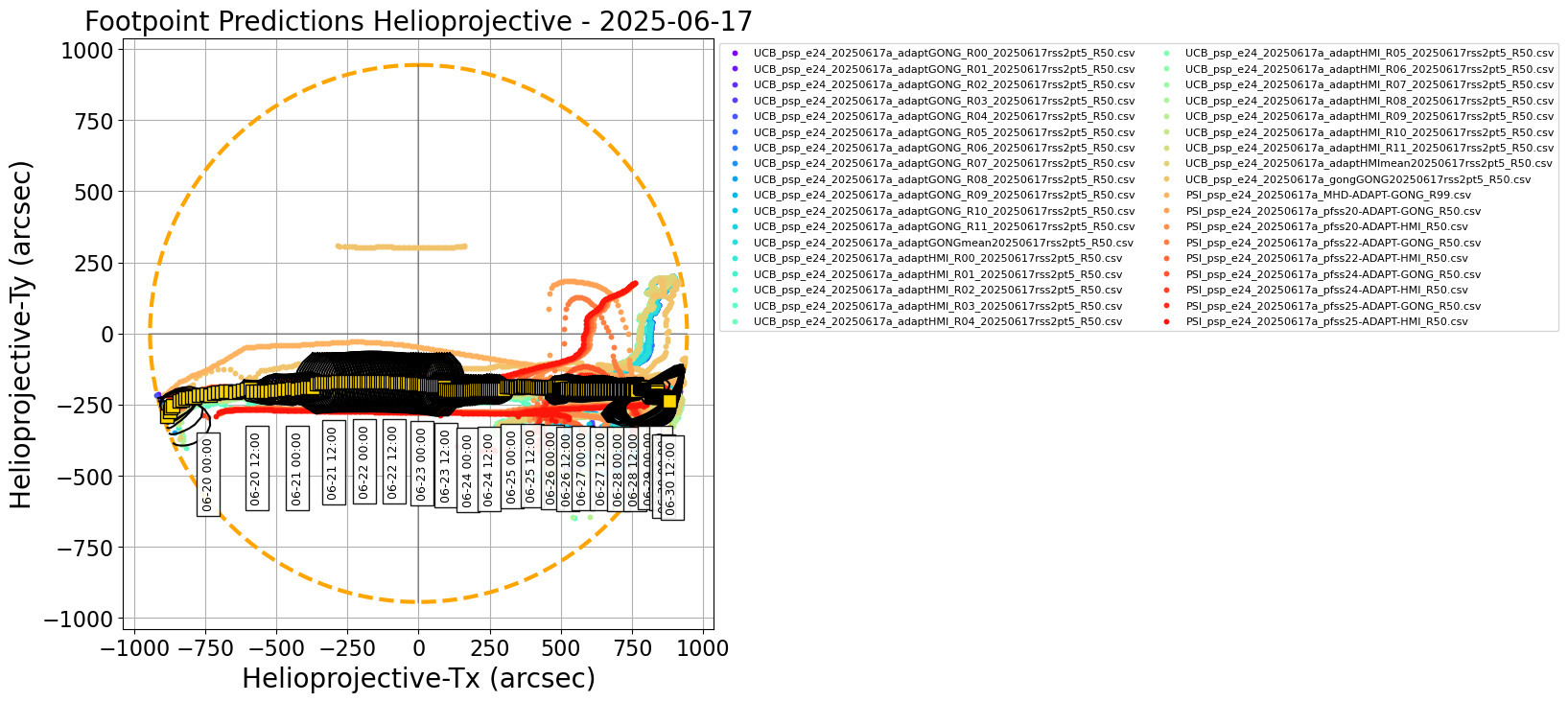
Figure 1.

Figure 2.
Figures above show one footpoint per day plotted on the solar disk and in Carrington coordinates (click on figure to zoom and see caption).
The predicted footpoints were kindly provided by the PSP 24rd Perihelion modeling team.
Encounter 24 Prediction update 1/6: 2025/06/17
------------------------------------------------
This is the first of six daily footpoint predictions issued for Parker Solar Probe Encounter 24, the third time Parker will reach its record-breaking perihelion of 9.86Rs. Perihelion 24 occurs on 2025/06/19 at 09:31 UT (05:31 EDT). Prior to perihelion, the inbound phase of this encounter is behind the East limb and perihelion occurs just prior to the footpoints emerging on disk . Parker's footpoints will then rapidly advance across the disk, reaching the central meridian on 6/21 and will remain on disk approaching the West limb slowly through the outbound phase of the encounter.
Magnetic Connectivity
---------------------
Connectivity prior to perihelion is expected to be a mid-latitude negative polarity coronal hole located well behind the limb. At perihelion, Parker's measurements will likely be associated with near-equatorial flows near the East limb and will be passing over active regions at that time. Subsequently, the footpoint prediction jumps to another negative polarity equatorial coronal hole which is expected to rotate on disk today (and should be verified prior to perihelion on Thursday). The jump to sources on disk is expected at 1300UT on 6/19 (4 hours after perihelion).
The footpoints are expected to quite simply track this coronal hole as it rotates on disk over the coming weeks - no other connectivity changes are seen in the models at this time.
The most relevant target for remote observers until after perihelion will be the near equatorial region at the East limb. SDO AIA image
Flare Likelihood (CCMC Flare Scoreboard)
----------------------------------------
As of 2025-06-17 at 12:00 UT, the CCMC Flare Scoreboard gave 24-hour average cumulative flare probabilities amounting to 99%, 57% and 13% for GOES C and above, M and above and X-class flares, respectively. The strongest flare observed over the past 24 hours was an M1.4 flare at 2025-06-16T11:27 originating from NOAA AR 14109 that followed a M6.3 flare earlier in the day (2025-06-16T09:17) from NOAA AR 14114. Sunspot complexes present in the solar disk include NOAA ARs 14110 - 14116, mostly on the northwestern solar quadrant, with only NOAA ARs 14112 and 14116 at southern latitudes of about 10 deg. A conspicuous coronal hole dominates the southern solar hemisphere.
From the CCMC CME Scoreboard, there is one active Earth-directed CME detected at 2025-06-17T01:36 from a source location N21E20 (NOAA AR 14115) with a speed of 464 km/s. This is a partial northeastern halo that seems to be interacting with a narrower CME detected from the same source an hour earlier (2025-06-17T00:38). The predicted shock arrival time at Earth-L1 is approx. 2025-06-20T18:00 (+/- 7 hours). The crossing is not expected to trigger a geomagnetic event, with a projected Kp in the range [3, 4].
------------------
*** Please note that the "arrival time" and "emission time" and associated Tx/Ty coordinates for both are reported in the consensus CSV file. The attached plots show the "arrival time" (location of source at time that plasma will arrive at PSP). See Parker Footpoint Predictions - Meaning and Terminology for some discussion on these***.
2025-06-18 (CSV, PDF table of coordinates)
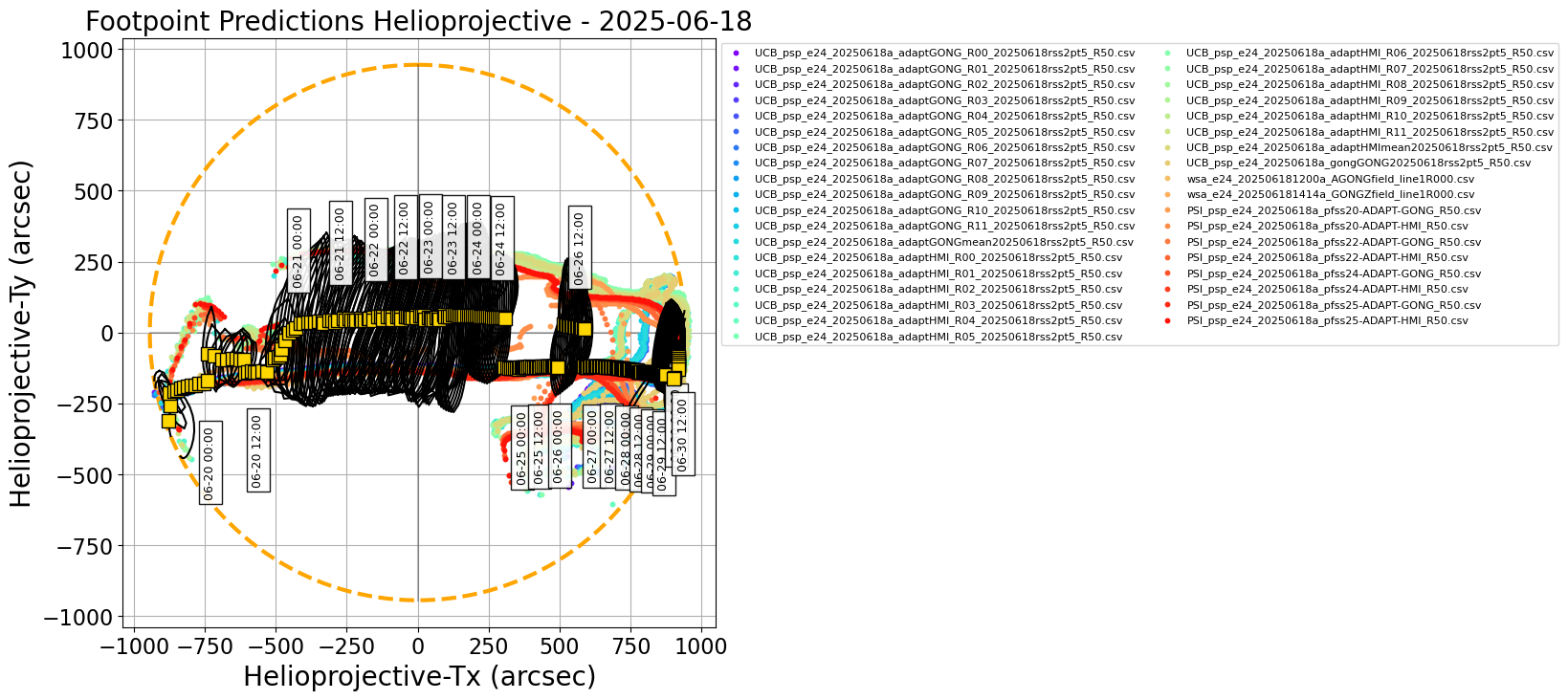
Figure 1.

Figure 2.
Figures above show one footpoint per day plotted on the solar disk and in Carrington coordinates (click on figure to zoom and see caption).
The predicted footpoints were kindly provided by the PSP 24rd Perihelion modeling team.
Encounter 24 Prediction update 2/6: 2025/06/18
------------------------------------------------
This is the second of six daily footpoint predictions issued for Parker Solar Probe Encounter 24, the third time Parker will reach its record-breaking perihelion of 9.86Rs. Perihelion 24 occurs tomorrow, 2025/06/19 at 09:31 UT (05:31 EDT). Prior to perihelion, the inbound phase of this encounter is behind the East limb and perihelion occurs just prior to the footpoints emerging on disk. Parker's footpoints will then rapidly advance across the disk, reaching the central meridian on 6/21 and will remain on disk approaching the West limb slowly through the outbound phase of the encounter.
Magnetic Connectivity
---------------------
Connectivity today until early tomorrow is expected to be a mid-latitude negative polarity coronal hole located well behind the limb. At perihelion (early UT tomorrow), Parker's measurements will likely be associated with near-equatorial flows near the East limb. From tomorrow 6/19 1200UT, the footpoint predictions jump to another negative polarity equatorial coronal hole which is rotating on disk today and just visible at the limb in this SDO image: 20250618_144935_1024_0211.jpg.
The footpoints remain expected to quite simply track this coronal hole as it rotates on disk over the coming weeks - no other connectivity changes are seen in the models at this time.
Flare Likelihood (CCMC Flare Scoreboard)
----------------------------------------
As of 2025-06-18 at 12:00 UT, the CCMC Flare Scoreboard gave 24-hour average cumulative flare probabilities amounting to 99%, 41% and 6% for GOES C and above, M and above and X-class flares, respectively, slightly lower than yesterday’s forecast. The strongest flare observed over the past 24 hours was an X1.2 flare at 2025-06-17T21:38 originating from NOAA AR 14114. Sunspot complexes present on the solar disk include NOAA ARs 14111 - 14116, all in the western solar hemisphere and most in the northwestern quadrant, with only NOAA ARs 14112 and 14116 at southern latitudes of about 10 deg. A conspicuous coronal hole dominates the mid-to-high latitude southern solar hemisphere.
From the CCMC CME Scoreboard, the update is as yesterday, with one active Earth-directed CME detected at 2025-06-17T01:36 from a source location N21E20 (NOAA AR 14115) with a speed of 464 km/s. This is a partial northeastern halo that seems to be interacting with a narrower CME detected from the same source an hour earlier (2025-06-17T00:38). The predicted shock arrival time at Earth-L1 is approx. 2025-06-20T18:00 (+/- 7 hours), with the crossing not expected to trigger a significant geomagnetic event.
------------------
*** Please note that the "arrival time" and "emission time" and associated Tx/Ty coordinates for both are reported in the consensus CSV file. The attached plots show the "arrival time" (location of source at time that plasma will arrive at PSP). See slide deck for some discussion on these***.
2025-06-19 (CSV, PDF table of coordinates)
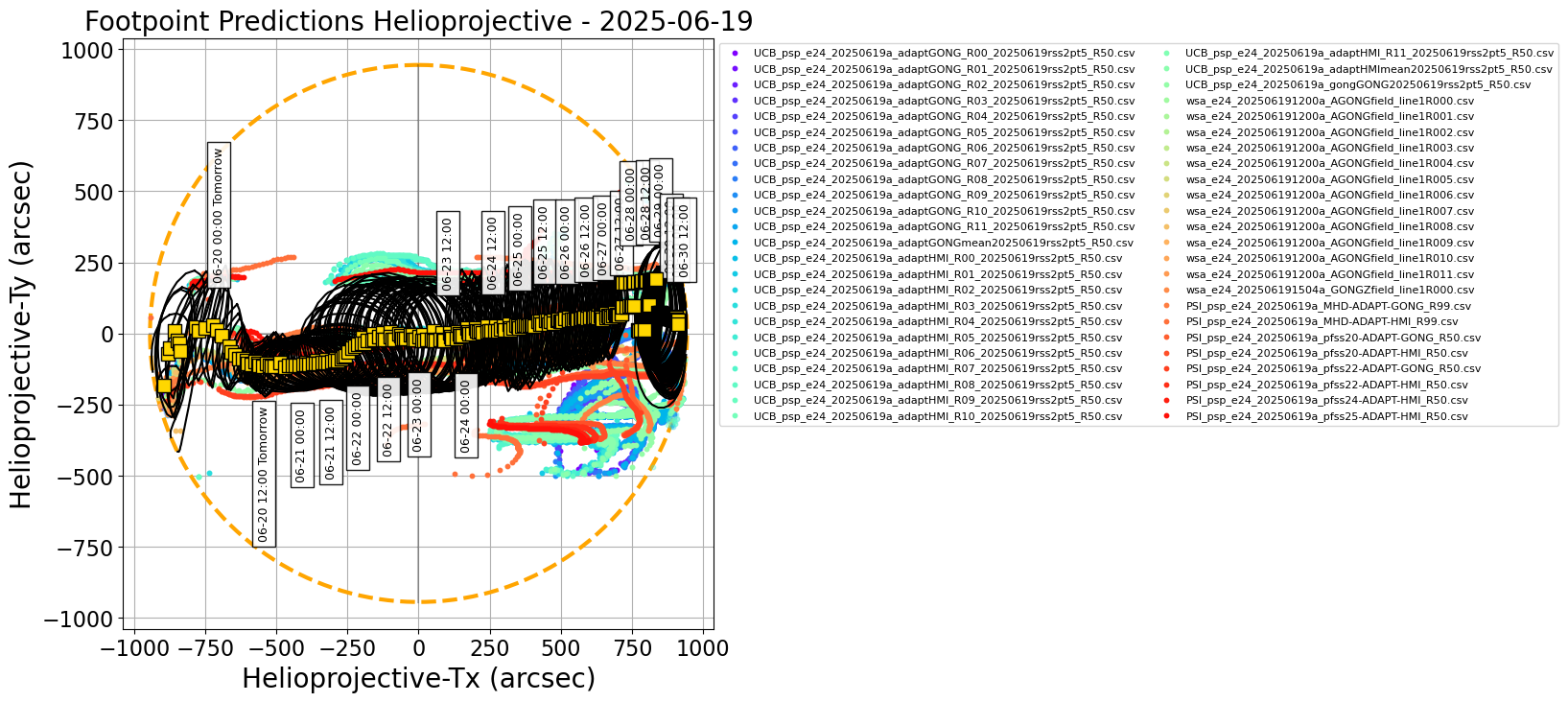
Figure 1.

Figure 2.
Figures above show one footpoint per day plotted on the solar disk and in Carrington coordinates (click on figure to zoom and see caption).
The predicted footpoints were kindly provided by the PSP 24rd Perihelion modeling team.
Encounter 24 Prediction update 3/6: 2025/06/19
------------------------------------------------
This is the third of six daily footpoint predictions issued for Parker Solar Probe Encounter 24. Perihelion 24 at 9.86 Rs occured earlier today, 2025/06/19 at 09:31 UT (05:31 EDT). The inbound phase of this encounter was behind the East limb and perihelion occurred just prior to the footpoints emerging on disk. Parker's footpoints are now likely on disk and predicted to connect to a single equatorial coronal hole source, tracking it as it rotates across the disk. Parker's heliographic location will reach the central meridian on 6/21 and its magnetic footpoints will remain on disk approaching the West limb slowly through the outbound phase of the encounter.
Magnetic Connectivity
---------------------
Footpoint predictions have now jumped to a small negative polarity equatorial coronal hole which is clearly visible on disk near the East limb today. The footpoints remain expected to quite simply track this coronal hole as it rotates on disk over the coming weeks - no other connectivity changes are seen in the models at this time, although the connectivity will vary in terms of connection to the center vs overexpanded field lines from the edge.
As discussed below, a newly named active region (AR 14117) is adjacent to (south of) this same coronal hole so is likely to be relevant to in situ measurements taken at this time.
Annotations of the predicted location of the source today and this new AR on a current SDO image are available here: Annotated slide.
Flare Likelihood (CCMC Flare Scoreboard)
----------------------------------------
As of 2025-06-19 at 12:00 UT, the CCMC Flare Scoreboard gave 24-hour average cumulative flare probabilities amounting to 99%, 41% and 7% for GOES C and above, M and above and X-class flares, respectively, virtually unchanged since the last update. The strongest flare observed over the past 24 hours was a C8.0 flare at 2025-06-19T09:06 from NOAA AR 14114. Sunspot complexes on the disk include existing NOAA ARs 14111 - 14116, with the new NOAA AR 14117 at high longitude and southern latitude (E56S16 heliographic). This is directly adjacent to the source region connection predicted above and so is likely to be encountered by the mission. The major coronal hole present in the disk continues to dominate the southwestern quadrant.
From the CCMC CME Scoreboard, the update is as yesterday, with one active Earth-directed CME detected at 2025-06-17T01:36 from a source location N21E20 (NOAA AR 14115) with a speed of 464 km/s. This was a partial northeastern halo that interacted with a narrower CME detected from the same source an hour earlier (2025-06-17T00:38). The predicted shock arrival time at Earth-L1 remains 2025-06-20T18:00 (+/- 7 hours), with the crossing not expected to trigger a significant geomagnetic event.
------------------
*** Please note that the "arrival time" and "emission time" and associated Tx/Ty coordinates for both are reported in the consensus CSV file. The attached plots show the "arrival time" (location of source at time that plasma will arrive at PSP). See slide deck for some discussion on these***.
2025-06-20 (CSV, PDF table of coordinates)
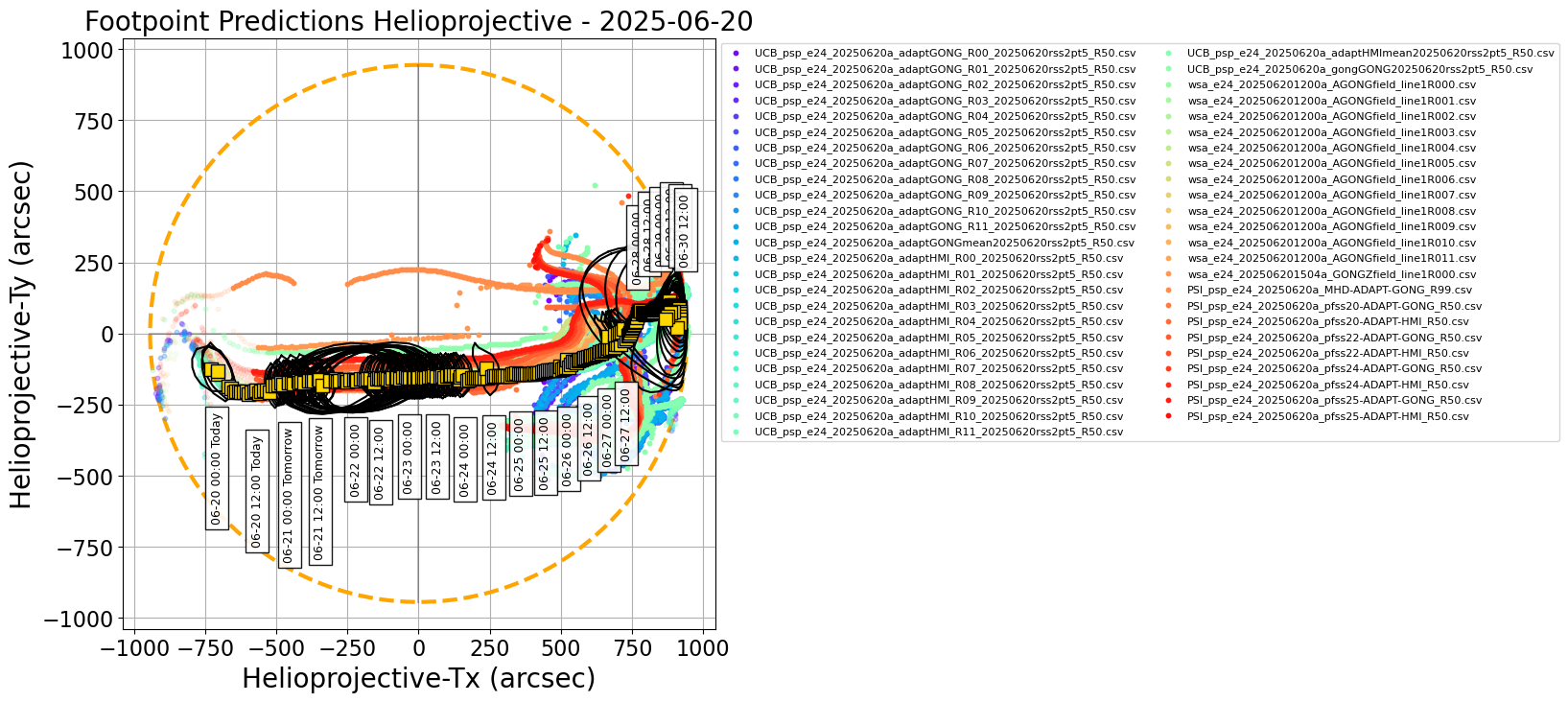
Figure 1.

Figure 2.
Figures above show one footpoint per day plotted on the solar disk and in Carrington coordinates (click on figure to zoom and see caption).
The predicted footpoints were kindly provided by the PSP 24rd Perihelion modeling team.
Encounter 24 Prediction update 4/6: 2025/06/20
------------------------------------------------
This is the fourth of six daily footpoint predictions issued for Parker Solar Probe Encounter 24. Perihelion 24 at 9.86 Rs occured on 2025/06/19 at 09:31 UT (05:31 EDT). The inbound phase of this encounter was behind the East limb and perihelion occurred just prior to the footpoints emerging on disk. Parker's footpoints remain on disk tracking a single equatorial coronal hole source as it rotates across the disk. Parker's heliographic location will reach the central meridian tomorrow (6/21) and its magnetic footpoints will remain on disk approaching the West limb slowly through the outbound phase of the encounter.
Magnetic Connectivity
---------------------
Footpoint predictions remain concentrated on a negative polarity equatorial coronal hole which is clearly visible on disk east of disk center today. The footpoints are expected to simply track this coronal hole as it rotates on disk over the coming weeks - no other connectivity changes are seen in the models at this time, although the connectivity will vary in terms of connection to the center vs overexpanded field lines from the edge.
As discussed below, a recently named active region (AR 14117) is adjacent to (southwest of) this same coronal hole and is likely to be relevant to in situ measurements taken at this time.
Annotations of the predicted location of the source today and this new AR on a current SDO image are available in this Annotated slide.
Flare Likelihood (CCMC Flare Scoreboard)
----------------------------------------
As of 2025-06-20 at 12:00 UT, the CCMC Flare Scoreboard gave 24-hour average cumulative flare probabilities amounting to 99%, 35% and 3% for GOES C and above, M and above and X-class flares, respectively, slightly lower than the last update. The strongest flare observed over the past 24 hours was an X1.9 flare at 2025-06-19T23:37, originating from NOAA AR 14114. Sunspot complexes on the disk include NOAA ARs 14111 and 14113 - 14117. All but NOAA AR 14117 are in western longitudes. NOAA AR 14117 corotates with a sizable coronal hole at its northeast, with the complex likely interacting with the coronal hole Parker will sample for the outbound phase of the orbit. The major coronal hole present in the southwest quadrant continues to dominate that part of the solar disk as it rotates toward the western limb.
From the CCMC CME Scoreboard, there are no changes since yesterday, with one active Earth-directed CME detected at 2025-06-17T01:36 from a source location N21E20 (NOAA AR 14115) with a speed of 464 km/s. This was a partial northeastern halo that interacted with a narrower CME detected from the same source an hour earlier (2025-06-17T00:38). The predicted shock arrival time at Earth-L1 is expected today (2025-06-20T18:00 +/- 7 hours) with no significant geomagnetic event predicted.
------------------
*** Please note that the "arrival time" and "emission time" and associated Tx/Ty coordinates for both are reported in the consensus CSV file. The attached plots show the "arrival time" (location of source at time that plasma will arrive at PSP). See slide deck. for some discussion on these***.
2025-06-21 (CSV, PDF table of coordinates)
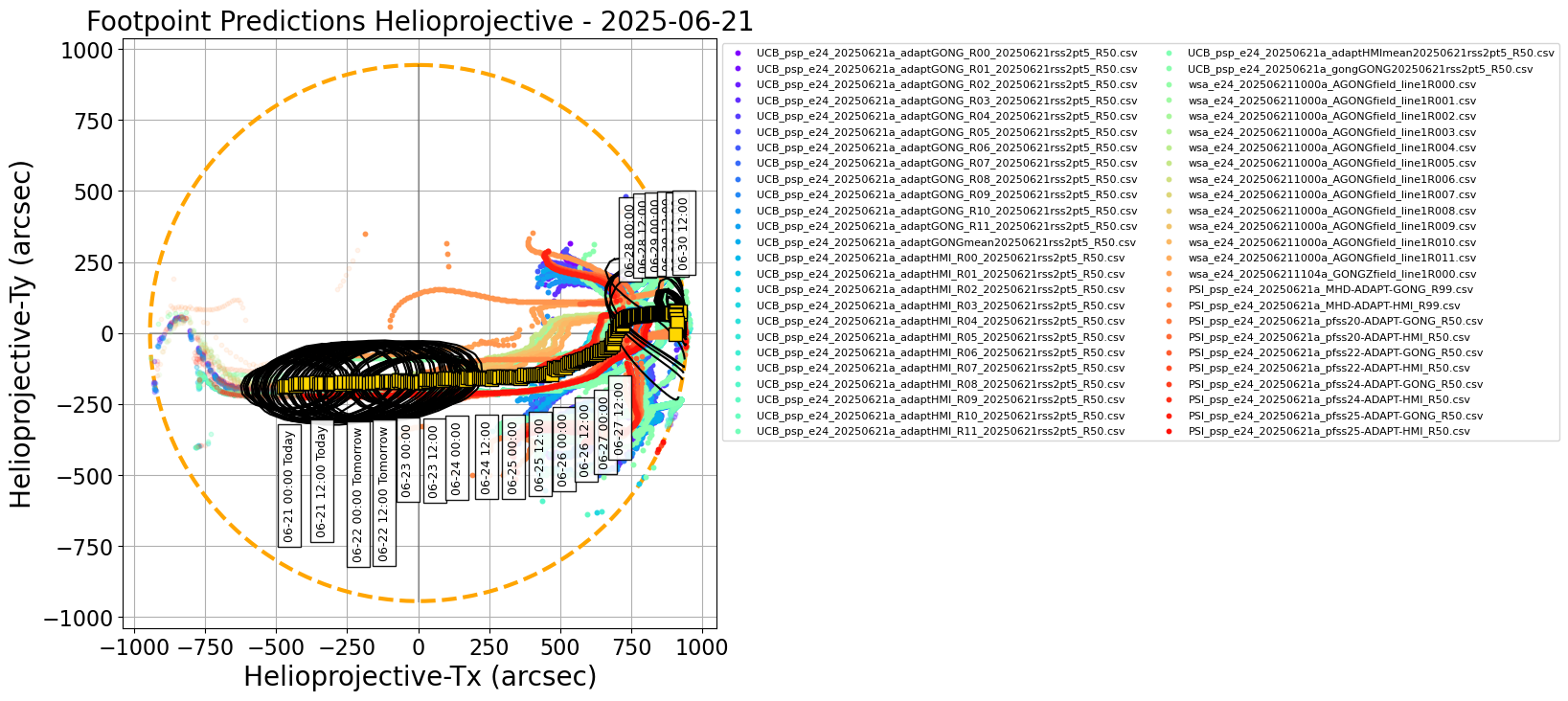
Figure 1.

Figure 2.
Figures above show one footpoint per day plotted on the solar disk and in Carrington coordinates (click on figure to zoom and see caption).
The predicted footpoints were kindly provided by the PSP 24rd Perihelion modeling team.
Encounter 24 Prediction update 5/6: 2025/06/21
------------------------------------------------
This is the fifth of six daily footpoint predictions issued for Parker Solar Probe Encounter 24. Perihelion 24 at 9.86 Rs occurred on 2025/06/19 at 09:31 UT (05:31 EDT). The inbound phase of this encounter was behind the East limb and perihelion occurred just prior to the footpoints emerging on disk. Parker's footpoints remain on disk tracking a single equatorial coronal hole source as it rotates across the disk. Parker is now in its outbound corotation phase so is moving at the same rate the Sun is rotating. Its magnetic footpoints will remain on disk approaching the West limb slowly through the outbound phase of the encounter.
Magnetic Connectivity
---------------------
Footpoint predictions remain concentrated on a negative polarity equatorial coronal hole which is clearly visible on disk and approaching disk center today. The footpoints are still expected to simply track this coronal hole as it continues to rotate westwards - no other connectivity changes are seen in the models at this time, although the connectivity will vary in terms of connection to the center vs overexpanded field lines from the edge.
As discussed below, a recently named active region (AR 14117) is adjacent to (southwest of) this same coronal hole and is likely to be relevant to in situ measurements taken at this time.
Annotations of the predicted location of the source today and this new AR on a current SDO image are available in this Annotated slide.
Flare Likelihood (CCMC Flare Scoreboard)
----------------------------------------
As of 2025-06-21 at 12:00 UT, the CCMC Flare Scoreboard gave 24-hour average cumulative flare probabilities amounting to 97%, 30% and 3% for GOES C and above, M and above and X-class flares, respectively, with little difference since the last update. The strongest flare observed over the past 24 hours was a M1.0 flare at 2025-06-20T17:21, originating from NOAA AR 14117. Sunspot complexes in the solar disk include NOAA ARs 14111 and 14113 - 14118. All but NOAA ARs 14117, 14118 are in extreme western longitudes. NOAA AR 14117 corotates with a sizable coronal hole at its northeast (where footpoints are predicted to connect to). The major coronal hole present in the southwest quadrant continues to dominate that part of the solar disk, with a significant section of it still visible.
From the CCMC CME Scoreboard, there are no changes since yesterday, with one active Earth-directed CME detected at 2025-06-17T01:36 from a source location N21E20 (NOAA AR 14115) with a speed of 464 km/s. This was a partial northeastern halo that interacted with a narrower CME detected from the same source an hour earlier (2025-06-17T00:38). The shock should have crossed Earth’s L1 yesterday (2025-06-20T18:00 +/- 7 hours) and did not trigger a geomagnetic event, as expected.
------------------
*** Please note that the "arrival time" and "emission time" and associated Tx/Ty coordinates for both are reported in the consensus CSV file. The attached plots show the "arrival time" (location of source at time that plasma will arrive at PSP). See slide deck for some discussion on these***.
2025-06-22 (CSV, PDF table of coordinates)
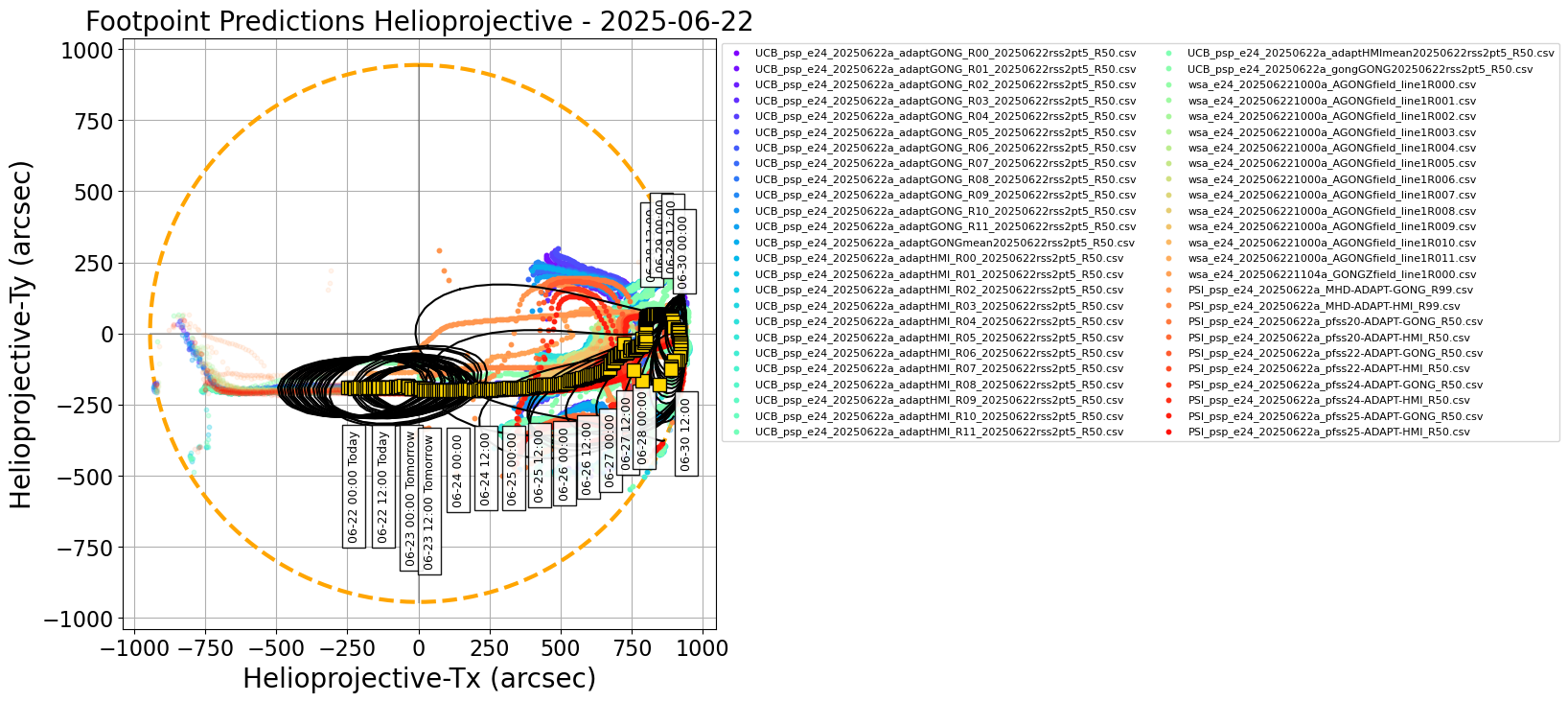
Figure 1.

Figure 2.
Figures above show one footpoint per day plotted on the solar disk and in Carrington coordinates (click on figure to zoom and see caption).
The predicted footpoints were kindly provided by the PSP 24rd Perihelion modeling team.
Encounter 24 Prediction update 6/6: 2025/06/22
------------------------------------------------
This is the final of six daily footpoint predictions issued for Parker Solar Probe Encounter 24. Perihelion 24 at 9.86 Rs occurred on 2025/06/19 at 09:31 UT (05:31 EDT). The inbound phase of this encounter was behind the East limb and perihelion occurred just prior to the footpoints emerging on disk. Parker's footpoints remain on disk tracking a single equatorial coronal hole source as it rotates across the disk, near disk center today. Parker is now in its outbound corotation phase so is moving at the same rate the Sun is rotating. Its magnetic footpoints will remain on disk approaching the West limb slowly through the outbound phase of the encounter.
Magnetic Connectivity
---------------------
Footpoint predictions remain concentrated on a negative polarity equatorial coronal hole which is clearly visible on disk and near disk center today. The footpoints are still expected to simply track this coronal hole as it continues to rotate westwards - no other connectivity changes are seen in the models at this time, although the connectivity will vary in terms of connection to the center vs overexpanded field lines from the edge.
As discussed below, a recently named active region (AR 14117) is adjacent to (southwest of) this same coronal hole and is likely to be relevant to in situ measurements taken at this time.
Annotations of the predicted location of the source today and this new AR on a current SDO image are available in this Annotated slide.
Flare Likelihood (CCMC Flare Scoreboard)
----------------------------------------
As of 2025-06-22 at 12:00 UT, the CCMC Flare Scoreboard gave 24-hour average cumulative flare probabilities amounting to 98%, 26% and 3% for GOES C and above, M and above and X-class flares, respectively, almost identical to the last update. The strongest flare observed over the past 24 hours was a GOES C1.3 at 2025-06-22T03:15, originating from NOAA AR 14114. Sunspot complexes in the solar disk include NOAA ARs 14113 - 14118. All but NOAA ARs 14117, 14118 are close to or on the western limb — NOAA ARs 14117, 14118 are still on the eastern hemisphere. NOAA AR 14117 corotates with the transequatorial coronal hole which has been the main footpoint connectivity target throughout this prediction campaign. The westernmost part of the major coronal hole present in the southwest quadrant is still on the disk and separates from the transequatorial coronal hole via a conspicuous, large-scale quiet-Sun filament.
From the CCMC CME Scoreboard, there is no active Earth-directed CME at this time. Magnetospheric conditions are quiet.
------------------
*** Please note that the "arrival time" and "emission time" and associated Tx/Ty coordinates for both are reported in the consensus CSV file. The attached plots show the "arrival time" (location of source at time that plasma will arrive at PSP). See slide deck for some discussion on these***.
Date and arrival time of plasma parcel at PSP, consensus carrington longitude (deg), latitude (deg), error in longitude, error in latitude, on-disk position of predicted source in X and Y (arcseconds) at arrival time, date and emission time of plasma parcel at the source, on-disk position of predicted source at time parcel is emitted. Each row is the updated source location each hour.
The consensus is generated by forming a distribution of footpoint predictions from all modelers for each hour period, and attempting to fit a Kent distribution. If the fitting fails, the median in longitude and latitude are quoted. If the fitting is successful, the quoted errors are formed by drawing random samples from the fitted distribution and computing the standard deviation in longitude and latitude of those samples. If the fitting fails, the quoted errors are the standard deviation in the longitude and latitude from the raw distribution of predictions. The full shape of the distribution is described by black contours in the associated plots on this website. More details about the procedure can be found at the following preprint of Badman et al. (2023) "Prediction and Verification of Parker Solar Probe Solar Wind Sources at 13.3Rs"
Please note the carrington coordinates (lon,lat) are valid from the quoted timestamp (in UTC) until the next timestamp. The helioprojective coordinates quoted (HP-Tx, HP-Ty) are computed from the carrington coordinate at the quoted timestamp (e.g. midnight UTC each day) and so are valid instantaneously at this time but will corotate with the Sun until the next quoted timestamp. For a discussion of the subtle difference in emission and arrival time and why both are included please see the slide deck.
Individual model prediction tables of coordinates may be found in a Public DropBox. Files in the Public DropBox have three-letter identifiers indicating the associated model (see below).
Three-letter designation for Public DropBox: UCB. Kindly provided by Sam Badman. The model is a simple ballistic propagation from PSP down to the source surface assuming slow wind 360km/s, and then tracing this sub-PSP trajectory through a PFSS model to get footpoints at the photosphere. The source surface height here is 2.5Rs. The PFSS model is generated using various ADAPT maps with GONG and HMI as input, and the model is run using the open source pfsspy package. A more detailed explanation of the model and comparison to PSP E1 results are given here.
Three-letter designation for Public DropBox: PSI. Kindly provided by Pete Riley. For these predictions, PSI is using a combination of modeling approaches, including PFSS solutions, empirically-based polytropic MHD solutions, and a more sophisticated approach that includes the effects of waves and turbulence to heat the corona and the WKB approximation for wave pressures to accelerate the solar wind. Additionally, boundary conditions are derived from both HMI and ADAPT synoptic magnetograms. Together, these allow us to generate a rich set of ensemble realizations from which to make our optimal prediction, as well as pool them with other teams’ forecasts to derive a hyper-ensemble prediction.
Three-letter designation for Public DropBox: wsa. Kindly provided by Shaela Jones. The Wang-Sheeley-Arge (WSA) model is a combined empirical and physics-based model of the corona and solar wind. The coronal portion of the Wang-Sheeley-Arge (WSA) model is comprised of the Potential Field Source Surface (PFSS) and Schatten Current Sheet (SCS) models, where the output of the PFSS model serves as input to the SCS model. The solar wind portion of WSA consists of a simple 1-D kinematic propagation code that takes stream interactions into account in an ad-hoc fashion. It provides predictions of the solar wind speed and interplanetary magnetic field IMF polarity at any specified point in the inner heliosphere. The WSA model can use global maps of the photospheric magnetic flux measurements from a number of sources as its inner boundary condition; here we are using an ensemble of maps from the Air Force Data Assimilative Photospheric Flux Transport (ADAPT) model, based on input GONG magnetograms.
UAH predictions come from the University of Alabama, Huntsville Multiscale Fluid-Kinetic Simulation Suite (MS-FLUKSS, Pogorelov et al. (2014); Pogorelov (2023); Singh et al. (2022)), which can solve the Reynolds-averaged ideal MHD equations for the mixture of thermal and nonthermal solar wind ions coupled with the kinetic Boltzmann equation describing the transport of neutral atoms. An adaptive mesh refinement technique can be employed for efficient high-resolution calculations. The MS-FLUKSS heliospheric MHD model is coupled with the WSA model (Kim et al., 2020), which uses both ADAPT-GONG and ADAPT-HMI input magnetograms, with the PFSS source surface height and the WSA outer boundary at 2.5 and 10 solar radii, respectively. Hence, field line tracing is performed through the MHD domain down to 10 solar radii instantaneously at approximately 1 hour cadence, where the origin of the field line on the photosphere is already known, as described for WSA.
see Prediction and Verification of Parker Solar Probe Solar Wind Sources at 13.3Rs, Badman et al. (2023)